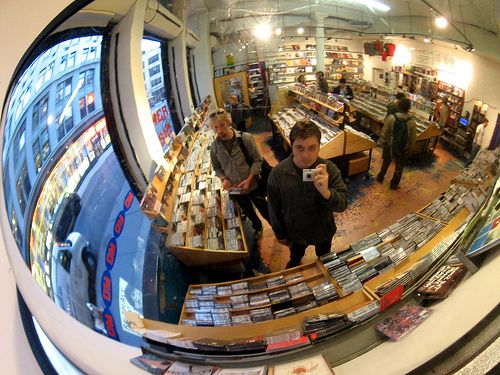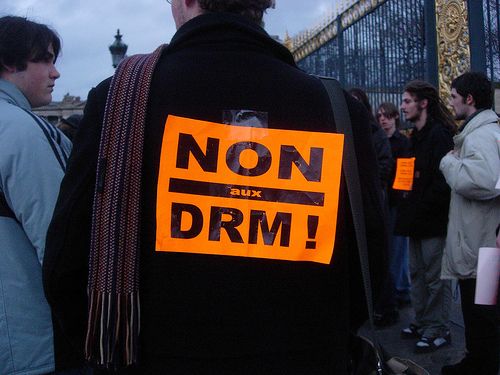
Listen to the mainstream press, and the story goes something like this: most online downloads have DRM. Then, major label EMI announced it would drop DRM from iTunes songs (for an additional per-song cost, at a higher bitrate). EMI, says this mainstream narrative, is the exception to the rule.
That’s missing an entirely separate narrative that’s unfolding, which is that many, many smaller labels are embracing new, smaller music stores.
They’re the polar opposite of Apple’s iTunes Music Store:
- They lack DRM. As of today, 100% of the iTunes Music Store is still DRM-protected, in a format only Apple-branded products can play. 100% of many other stores is DRM-free. Their overall catalog is generally smaller, but depth in their areas of specialization can actually be greater, because —
- They’re niche-y. They embrace various niches rather than pushing top-of-the-charts tastes. Think long tail rather than top 20 Casey Casum. (Nothing against Casey; he’s part Lebanese-American so we’re probably distant cousins.)
- They support cross-platform formats. iTunes-purchased tracks work on iPods, Macs, and Windows, but not any other players or Linux. Windows Media files with copy protection don’t work on Macs, Linux, iPods, or some cheaper/foreign players (at least, not without some work in these categories). By supporting formats like MP3 and OGG, these alternative stores support both mainstream hardware and software (iPod, Zune, Windows Media Player, iTunes, etc.) and anything else you’ve got. And since there’s no DRM, you can mix and match at will. (Yes, WMA and AAC can technically be added to players, and AAC is even part of MPEG-4 — but the availability of MP3 for purchase does make for a better common-denominator format.)
- They’re high-bitrate. AAC as used by Apple and (some argue) even Microsoft’s WMA perform better at lower bitrates than the older MP3 format. But we’re still talking lossy compressions at relatively low data rates. Antiquated as the format may be, 320 kbps MP3s sound closer to CDs. If you can still hear the difference, some stores even let you opt for lossless tracks.
- They’re more like your neighborhood store. iTunes is Wal-Mart to the neighborhood feel of stores like Bleep and Other Music, built around the store or around labels with close-knit audiences. Some of these stores (Other Music, Dance Tracks Digital) even have brick-and-mortar counterparts, just as independent and used booksellers have recently benefited from the ability to extend their business to Web customers.
The most recent bombshell was Other Music’s new digital store, as mentioned on Wired’s Listening Post blog in January. Other launched its new store in April. Why does this matter? Because Other is an international landmark in the indie music scene, a hub for indie lovers and now-famous musicians in New York’s East Village. Unlike iTunes, it’s not a manufactured thing: it’s a real, live store, and some of its owners’ unique tastes and relationships with music are reflected in its online counterpart. As a brand, that means it already has an association with music experts. And tens of thousands of tracks are pouring into this store from music labels, many of whom are underrepresented or missing entirely from stores like iTunes. Now, they’re available online, at high bitrates, without DRM, and a ravenous group of music lovers is likely to take notice.
Other’s not alone, either.
The electronica scene has already been hip to DRM-free online downloads, with stores like Bleep, Dance Tracks Digital, 3BeatDigital, and Beatport. These stores can also cash in as DJs look to fill their virtual record crate. The US-based Dance Tracks Digital and the UK’s 3BeatDigital both offer tracks pre-warped for Ableton Live, and Beatport recently announced, in continuation of its ongoing relationship with Native Instruments, its music store would be fully integrated into NI’s new Traktor Scratch. But the indie music scene, naturally a little less enthusiastic about technology than people who make music almost exclusively on computer screens, is also starting to come around.
Additional stores in other genres are starting to catch hold, too. AllAboutJazz.com, the popular jazz portal, has launched its own community and online store. The model is similar: 320-kbps MP3s, focused on a market that has typically been under-served (increasingly of late), built into a community. As bandwidth prices come down, there may be more.
There are two ways to read this. One is to see this as a larger trend away from DRM, as many in the blogosphere does. Sonific’s Gerd Leonard, who co-authored the recent book The Future of Music, sees eMusic.com as the future and indie labels as swimming against the tide. The problem is, Gerd assumes that consumers want to pay less for music and that being DRM-free is enough. eMusic is a classic example of how this overly simplistic model can go horribly wrong. Music for a label is a business, and eMusic simply prices everything so low that their stock turns into a random bargain-bin of tracks, priced to grow their business but not to provide any incentive for labels to participate — and without any sense of how consumers will perceive value in the result. eMusic’s not a total failure; some readers here really like it. But labels have every right to try to set prices and margins at a point that makes money for them. To claim otherwise would be to ignore basic business principles, not the least of which being cheaper is not always better. (The classic example: look at how much Starbucks charges for a latte. As a result, their margins are higher, and their perceived value is greater, even if the product itself is just foam. You can’t write books about this stuff, of course, because it’s business 101. It ain’t sexy — but it might just be the reality.)

I see a different trend. Yes, DRM is out, if for no other reason than many labels are starting to realize it’s not actually making them money and consumers are freer with their wallets if it’s not there. Yes, competition for the bigger online stores has a bright future, if only because the big stores are reaching a certain saturation point. The key is, by playing to the niche, you play to a potentially more lucrative customer: the musical maven who cares about what they’re buying, and buy more. How many casual music purchasers do you know who use the iTunes Music Store just because it was there? Now, think about their buying patterns. I bet a lot of them just picked up some singles here and there, maybe an album or two, and ripped the rest of the 30-50 CDs they already own. (The argument about most iPod space being filled with pirated music ignored the fact that a lot of musical newbies have no idea what something like 20 GB actually means, and leave a lot of it empty, using ripped CDs for the rest because it’s what they know.)
What about the music mavens you know? They’re the ones with hundreds or thousands of CDs in their collection, who still insist upon stopping by that indie record store when they’re traveling and clearing out their inventory, who then wind up running up a few hundred dollars in bills on an online indie electronica label late one Friday night. Right?
As labels and smaller stores struggle to survive (Other Music recently watched titan Tower Music close only blocks away), these online stores could become a refuge to a struggling business. And that, in turn, could lead the mavens to start to influence their friends. DRM in general, of course, won’t die until other majors (not just EMI) drop it, because the mainstream market still looks for music they recognize from the radio, even if they’re more balkanized than before by factors like ethnicity and taste.
Here’s the bottom line: in general, most music listeners care far more about actual music than they do about the ideological battles that obsess pundits on the Internet. But what these online stores do offer is a tangible, practical experience that’s better than what big stores offer, even with music player integration on tools like iTunes. They offer music that’s more likely to cater to specific tastes, organized in a way that makes it easier to find and discover, in formats that sound better, work with more hardware and software, and create less hassle.
It’s going to be a long slog tweaking these online sites, getting music from labels, and getting the word out. But in the long haul, if some of these smaller stores can be successful at doing this, I believe musicians and listeners alike can only benefit.
In the meantime, I may take advantage of the fact that Other’s physical store isn’t far from my neighborhood.
Previously:
Where do you get your DRM-free music?